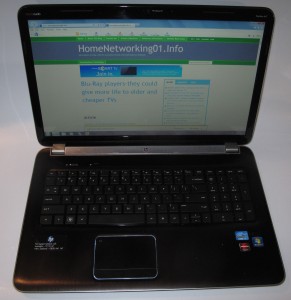 A trend that I have seen with laptop computers and some all-in-one desktop computers is for them to have their sound output “tuned” by a company involved in the recording or reproduction of music. In a similar vein to how a motor-racing team will work a car destined for street use to improve its performance, these firms, such as Harman (JBL), Bang & Olufsen or Dr. Dre’s Beats Audio, will work on the sound-reproduction systems to improve the computer’s sound reproduction, whether through its integrated speakers or through headphones attached to the computer.
A trend that I have seen with laptop computers and some all-in-one desktop computers is for them to have their sound output “tuned” by a company involved in the recording or reproduction of music. In a similar vein to how a motor-racing team will work a car destined for street use to improve its performance, these firms, such as Harman (JBL), Bang & Olufsen or Dr. Dre’s Beats Audio, will work on the sound-reproduction systems to improve the computer’s sound reproduction, whether through its integrated speakers or through headphones attached to the computer.
The main issue that these efforts are trying to conquer is the tinny sound that emanates from the typical laptop speakers. Previously, these computers used just a pair of small speakers installed in their small chassis that didn’t yield good bass or midrange reproduction and they were driven via a low-power stereo amplifier in the computer. The setup was just good enough for audio prompts and, in some cases, speech from people without accents, yet did a horrendous job at reproducing music or sound effects in video or game content. This is compared to the way even a cheaper portable radio or tape player that is equipped with the traditional 3” cone speaker can reproduce most frequencies “across the board”. It is made easier due to these sets having a larger cabinet that isn’t crammed out with circuitry and reproducing sound through a larger speaker with a deeper cone. End-users are asking a lot more out of their computers as they use them as personal jukeboxes, movie players and games machines or businesses make heavy use of them as voice and video telephony endpoints.
 The challenge is to keep these computers slim yet yield a proper and desirable sound across the audio spectrum. Typically the modifications will focus on the sound-reproduction and amplification circuitry as well as the integrated speakers. For example, there will be digital-sound-processing circuitry that works as a tone control for the computer, with the ability to improve the tone for the integrated speakers.
The challenge is to keep these computers slim yet yield a proper and desirable sound across the audio spectrum. Typically the modifications will focus on the sound-reproduction and amplification circuitry as well as the integrated speakers. For example, there will be digital-sound-processing circuitry that works as a tone control for the computer, with the ability to improve the tone for the integrated speakers.
There will be the implementation of Class-D power amplifier circuitry that is designed by people in the audio industry and the sound will emanate from a multi-way speaker system. An example of this is the ASUS Ultrabooks implementing Bang & Olufsen ICEPower audio amplification. Most systems will use a 2.1 speaker setup with a separate bass driver that may be separately amplified, but some may use a multi-way speaker setup with many speaker units to achieve the sound of larger traditional speakers. As well, there would be some work on planning out the speaker-enclosure area to allow the sound to come out of the system properly.
From what I have noticed when I reviewed many of the laptops, I have come across some setups where the speakers can be muffled easily when you rest your hands on the palmrest, or some computers may sound better when placed on a harder surface. I have also noticed that the screen area isnt necessarily used on most laptops as a place to locate speakers because when you have speakers there, you can improve the stereo separation and sound localisation there.
There are still the many challenges ahead for these sound-tuning projects, where there is an expectation to yield that punchy bass from the built-in speakers. This is usually the kind of stuff that the marketers hype on about when they promote the computers that are equipped with these sound-tuning efforts. Other than that, these efforts have succeeded in putting the life back in to sound reproduction from the larger “new-computing-environment” laptop computers.

What is the sound-tuning that is now implemented in laptops all about?
The main issue that these efforts are trying to conquer is the tinny sound that emanates from the typical laptop speakers. Previously, these computers used just a pair of small speakers installed in their small chassis that didn’t yield good bass or midrange reproduction and they were driven via a low-power stereo amplifier in the computer. The setup was just good enough for audio prompts and, in some cases, speech from people without accents, yet did a horrendous job at reproducing music or sound effects in video or game content. This is compared to the way even a cheaper portable radio or tape player that is equipped with the traditional 3” cone speaker can reproduce most frequencies “across the board”. It is made easier due to these sets having a larger cabinet that isn’t crammed out with circuitry and reproducing sound through a larger speaker with a deeper cone. End-users are asking a lot more out of their computers as they use them as personal jukeboxes, movie players and games machines or businesses make heavy use of them as voice and video telephony endpoints.
There will be the implementation of Class-D power amplifier circuitry that is designed by people in the audio industry and the sound will emanate from a multi-way speaker system. An example of this is the ASUS Ultrabooks implementing Bang & Olufsen ICEPower audio amplification. Most systems will use a 2.1 speaker setup with a separate bass driver that may be separately amplified, but some may use a multi-way speaker setup with many speaker units to achieve the sound of larger traditional speakers. As well, there would be some work on planning out the speaker-enclosure area to allow the sound to come out of the system properly.
From what I have noticed when I reviewed many of the laptops, I have come across some setups where the speakers can be muffled easily when you rest your hands on the palmrest, or some computers may sound better when placed on a harder surface. I have also noticed that the screen area isnt necessarily used on most laptops as a place to locate speakers because when you have speakers there, you can improve the stereo separation and sound localisation there.
There are still the many challenges ahead for these sound-tuning projects, where there is an expectation to yield that punchy bass from the built-in speakers. This is usually the kind of stuff that the marketers hype on about when they promote the computers that are equipped with these sound-tuning efforts. Other than that, these efforts have succeeded in putting the life back in to sound reproduction from the larger “new-computing-environment” laptop computers.
Related Posts
The DTS Play-Fi multiroom audio platform now supports network-based surround sound
Sony enters the network CD receiver market as part of their new home AV lineup
It doesn’t take long for the French to consider an Android-driven TV décodeur
About The Author
simonmackay